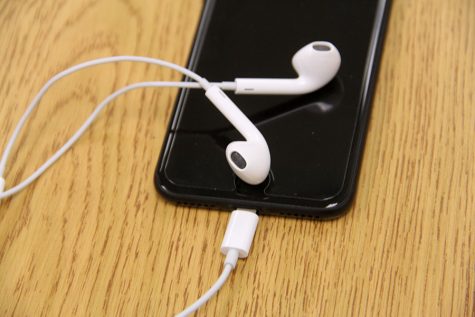A cup of tech: iPhone 7 overview
October 6, 2016
The iPhone 7 and 7 Plus have been met with both criticism and love. An obvious source of criticism is that Apple broke its pattern of releasing a new iPhone design every other year, but two new finishes bring elegance and beauty to the design. The headphone jack is gone, breaking many people’s promises that they would upgrade to this device, but the new stereo speakers bring an immersive audio experience. This phone is an extremely polished example of what Apple can do with user experience, but it lacks in some areas that are important, like screen resolution or design.
As far as negatives go, the iPhone 7 and 7 Plus are the same thickness as the iPhone 6S, and the camera humps on both new iPhones are even more pronounced. Apple’s new wide color gamut Retina display also lags behind competition, like the Samsung Galaxy Note 7, in resolution and clarity. The display allows for more colors are able to be shown on the screen and the colors look richer but the resolution is still much lower than many Android phones. When you compare the Note 7 and iPhone 7 side-by-side, this is very clear. However, one area that shines for the iPhone 7 is the new water resistant housing. The iPhone 7 and 7 Plus are truly water resistant with an IP67 rating. This means the phone is completely dust resistant and can be submerged in water up to 1 meter for 30 minutes. The waterproofing does its job, even after I swam with the phone for 5 minutes.
There are also new stereo speakers on the iPhone 7. The front speaker is now much louder and works together with the speaker on the bottom of the phone to create a stereo sound system. The audio sounds good overall – not great, but good enough that it is no longer annoying to watch videos on your phone. It is a definite improvement over the previous generation of iPhones, but has room for improvement.
The iPhone 7 and 7 Plus do not have a standard 3.5mm headphone jack. Instead of connecting your headphones through the headphone jack, you will now connect them through the lightning port. Apple provides each iPhone 7 purchase with a pair of EarPods with this new lightning connection. If you prefer wireless headphones, they pair via Bluetooth. If you buy Apple’s wireless AirPods, they will pair with all of your Apple products at the touch of a button using a new chip embedded in the iPhone 7 and AirPods. Overall, I have only been minorly inconvenienced by the lack of a headphone jack. I used the 3.5mm to headphone to lightning adapter in my car to listen to music through my auxiliary cord. It works great. Some people are having trouble using this with the auxiliary port in their car, but it works for me.

Apple’s new ear pods connect to the lightning port rather than the headphone jack, which was removed in this generation of iPhone
Removal of the headphone jack left room for a key feature used in the home button. The home button has been completely redesigned. Instead of a physical click button, the home button is now a piece of glass over Apple’s Taptic Engine, a small vibration engine that delivers vibrations all over your phone. These are not weak vibrations. These feel firm and premium. When you click the home button, instead of pushing down, a vibration occurs that mimics a physical pressing. When I first tested out this phone, I did not realize that the home button no longer physically pushed down. It genuinely feels like a real click.
Inside these phones is an Apple A10 Fusion quad-core chip with an embedded M10 motion coprocessor. Simply speaking, there are four different “cores” in the chip. Two of them are used for low-power processes like checking emails and messaging. The other two cores are for high-performance activities like gaming and working with iMovie. I upgraded from an iPhone 6 Plus and I could immediately tell a difference.
The second generation Touch ID fingerprint scanner built into the home button is so fast you can barely see the time on the lock screen flash by if you unlock your phone using this feature. Apps like Snapchat, which used to be a pain to wait for to load, are now smooth, effortless, and instantaneous. All the classic animations that Apple has included in its iOS software for its iPhones no longer lag and distract the user from simple tasks.
The cameras on the iPhone 7 and 7 Plus are incredible. Both the iPhone 7 and 7 Plus have an improved camera system from previous generations. With an ƒ/1.8 aperture lens on the iPhone 7 and 7 Plus, pictures in low light are improved from the iPhone 6S, which has a ƒ/2.2 aperture lens. As the aperture of the camera decreases in size, the amount of low light the camera lens lets in increases. This is why Apple is able to accomplish better low light photos with the iPhone 7. Video on both the 7 and 7 Plus looks great. This is to be expected as pictures look wonderful as well. Video quality can be set up to 4K at 30fps and is smooth and lifelike.
However, it’s the iPhone 7 Plus that really steals the show. The iPhone 7 Plus has a second telephoto lens that serves as an optical 2x zoom. The two cameras are always working together, determining the best settings to make your photos look the best. Apple has announced a new “Portrait Mode” on the iPhone 7 Plus that uses both lens to create a “bokeh” effect or blur on the background of a photo that was previously only available on high quality DSLR cameras. I was fortunate enough to be able to test it out.

Left: A standard low-light photo taken with the iPhone 7 plus.
Right: A low-light photo taken with the “bokeh” effect creating a depth of field.
While the blur is computer generated, it looks very realistic. I was fortunate enough to be able to test out this feature on the iPhone 7 Plus. The effect is spectacular but it is not complete. Sometimes edges of the subject are blurred out and Portrait Mode will not work in low light situations. If it becomes too dark, the subject looks very grainy and the photo is ruined. The system is also very picky about how far away you need to be from the subject and it will sometimes autofocus on the wrong thing. It’s nowhere near finished but it is a great start and really shows what this phone’s capabilities can go in the future.
Even though the iPhone 7 Plus is technically better than the iPhone 6S, it is not worth the upgrade if you have an iPhone 6S.
The upgraded camera and water resistance are nice, but phones are still too expensive to be convenient or worth the money for such a small upgrade. Even the design is the same between the iPhone 6, 6S, and 7.
It should also be mentioned that there are also many Android phones on the market to compare to the iPhone 7 that are much better spec-wise.
If you have an iPhone 6 or below, it may be worth your money to upgrade to the iPhone 7 or 7 Plus. You will be getting loads of new features like 3D Touch, crisper photos, and better battery life. It feels more like an iPhone 6SS, that is the phone before the iPhone 7, than a whole new generation of iPhone. However, the iPhone 7 and 7 Plus are still great phones that meet many people’s needs and the new features outweigh the few negatives.
Pros:
- Great camera especially on the iPhone 7 Plus
- Better battery life
- Water Resistance with an IP67 Rating
- Stereo Speakers
- Taptic Engine
Cons:
- Inconvenience of no headphone jack
- Design is almost exactly the same as the iPhone 6 and 6S
- Display is not up to competition’s levels






